Organic Farming in Scotland, 2015 Statistics
Provides a summary of organic land, producer, crop and livestock numbers, with UK comparisons.
Organic Farming in Scotland, 2015 Statistics 13th June 2016
Organic land area (fully organic or in conversion)
Chart 1: Organic land in Scotland, UK and Europe, 2002 to 2015
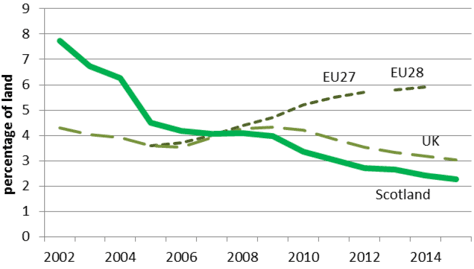
The area of organic land in Scotland fell seven per cent in 2015, down to 126,000 hectares. Of this, 1,000 hectares were still in the process of conversion to organic status.
This was the seventh consecutive fall in the area of organic land. The total area is now equivalent to 2.3 per cent of agricultural land in Scotland, compared to 3.0 per cent in the UK as a whole. Scotland now has just under a quarter of the UK's organic land.
In 2002 almost eight per cent of agricultural land in Scotland was organic, almost double the rate in the UK. But this fell sharply and by 2007 the rate was about four per cent, matching that across the UK, and since then Scotland has been below the rest of the UK.
In Europe, the percentage of farmland that is organic has been rising, reaching nearly six per cent in 2014.
Organic producers and processors
Chart 2: Organic producers and processors, 2005-2015
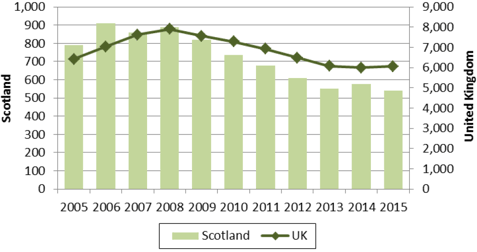
The number of organic producers in Scotland fell six per cent to 539, down from 576 in 2014. The number has been generally falling since 2008, as it has been in the UK as a whole. However, the UK figure for 2015 of 6,056 was a slight increase on the 2014 figure.
Organic land-use
Chart 3: Organic land-use in Scotland and UK, 2015
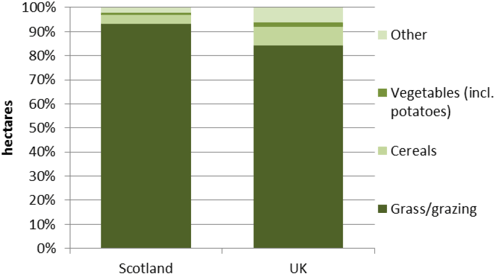
Most of the organic land in Scotland was pasture (permanent and temporary grassland and rough grazing). This accounted for 118,000 hectares, or 93 per cent of Scotland's organic land and three per cent of Scotland's pasture.
Chart 4: Percentage of land that is organic, 2014 and 2015
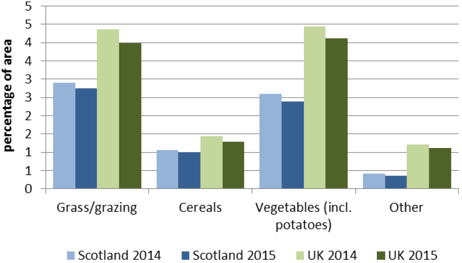
There was also 4,500 hectares of cereal (four per cent of organic land and one per cent of Scotland's land growing cereals).
There was also 1,000 hectares growing organic vegetables (including potatoes), which was one per cent of organic land and two per cent of land growing vegetables in Scotland.
Organic livestock
Chart 5: Percentage of livestock that are organic, 2014 and 2015
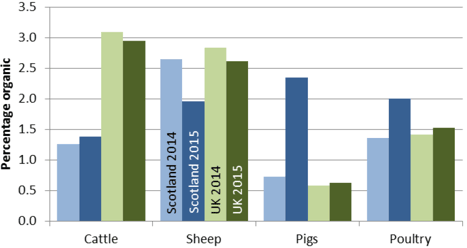
About 25,000 cattle in Scotland, or 1.4 per cent of Scotland's total, were certified organic. This was ten per cent up on 2014. There were 131,000 sheep (2.0 per cent, down 26 per cent), 7,500 pigs (2.3 per cent, more than trebled on 2014), and 262,000 poultry (2.0 per cent, up 30 per cent) that were certified organic.
The rates in Scotland were lower than for the UK as a whole for cattle and sheep, but higher for poultry and pigs.
Data source
This release contains data compiled by the UK Organic Certification Bodies. The data are sent to DEFRA each year to form the annual return required under European Commission Regulation No 889/2008. The data do not represent a snapshot at a particular date, but give the position on farms when they are inspected by the certifier bodies at some point during the year.
Please visit www.gov.uk/government/organisations/department-for-environment-food-rural-affairs/series/organic-farming for more information regarding this survey.
If you have any questions or comments about this publication, please e-mail agric.stats@gov.scot, or phone 0300 244 9716
In conversion
Only food that has been produced in accordance with standards set out by EU regulation may be sold as "organic" within the EU. In most cases land must be managed organically for at least two years before it becomes eligible for organic status. The data in this publication generally include those still within the two year conversion period.
Data tables
The data used to create the charts in this publication are available online in the accompanying spreadsheet.
Contact
There is a problem
Thanks for your feedback